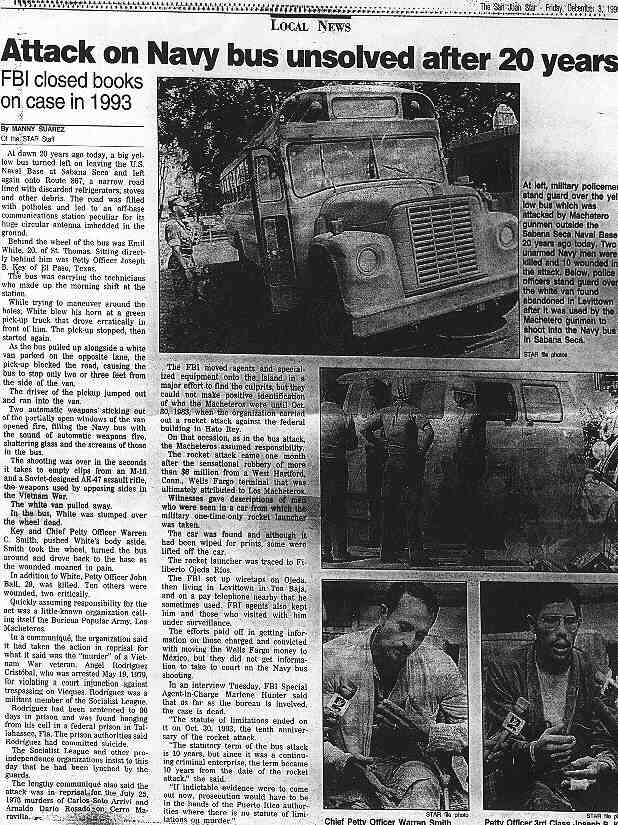
The Cerro Maravilla Incident, also known as the Cerro Maravilla Case or the Cerro Maravilla Killings (Caso del Cerro Maravilla or Asesinatos en Cerro Maravilla in Spanish, respectively) is the name given by the Puerto Rican public and media to describe the events that occurred on July 25, 1978 at Cerro Maravilla, a mountain in Puerto Rico, where in two young Puerto Rican pro-independence activists were killed in a police ambush. The event sparked a series of political controversies where, in the end, the police officers were found guilty of murder and several high-ranking local government officials were accused of planning and/or covering-up the incident.

Originally declared a police intervention against terrorists, the local media quickly questioned the officers" testimonies as well as the only surviving witness for inconsistencies. Although reluctant, the Governor of Puerto Rico at the time Carlos Romero Barcel? ordered the local Justice Department to launch various investigations, and asked the FBI and the US Justice Department to aid in such investigations, which concluded that there was no wrongdoing on the officer"s part. However, after the local opposing political party launched its own inquiries, new evidence and witness testimonies uncovered gross negligence and murder on the officers" part, as well as the possibility of a local and federal cover-up. Local trials were held, and a total of 10 officers were convicted of various crimes.

The incident and subsequent events have become one of the most controversial moments in Puerto Rico"s political history. The event is often referred to by local independence activists as an example of political oppression against the Puerto Rican independence movement. To this date, most public figures, including those which were not involved in the case, rarely comment on the incident.

The incident
On
the night of July 25, 1978 Carlos Soto Arriv and Arnaldo Daro Rosado,
two independence activists of the Armed Revolutionary Movement
(Movimiento Revolucionario Armado in Spanish), along with undercover
police officer Alejandro Gonzalez Malavé posing as a fellow group
member, took taxi driver Julio Ortiz Molina hostage and ordered him to
drive them to Cerro Maravilla where several communication towers were
located. Their original plan was to set fire and sabotage the towers to
protest the imprisonment of Puerto Rican nationalists convicted of the
1950 assassination attempt on U.S. President Harry S. Truman and the
1954 shooting at the United States Capitol where five members of
Congress were injured. State police officers were alerted of their plan
prior to their arrival and the activists were ambushed and shot. The
undercover agent received a minor bullet wound during the shooting,
while the taxi driver was left unharmed.
Aftermath

The second investigations led to 10 officers being indicted and found guilty of perjury, destruction of evidence, and obstruction of justice, of which 4 were convicted of second-degree murder during 1984.

The convicted officers, which were not on active duty at the time due to various reasons, were:
Col. ?ngel Pérez Casillas (head of the PR Police Department’s Intelligence Division during the incident; suspended)
Lieut. Nelson Gonz?lez Pérez (resigned),
Lieut. Jaime Qu?les Hern?ndez (suspended),
Officer Juan Bruno Gonz?lez (suspended),
Officer William Col?n Berr?os (suspended),
Officer Nazario Mateo Espada (suspended),
Officer Rafael Moreno Morales (suspended),
Officer Luis Rever?n Mart?nez (on disability leave),
Officer Jose R?os Polanco (suspended), and
Officer Rafael Torres Marrero (on disability leave).

That same year, in the general elections held in November, Romero Barcel lost his gubernatorial seat against former governor and opposing party rival Rafael Hernandez Colin (PPD). It is widely accepted that Romero Barcel lost the elections because of this case, since his public opinion rating had deteriorated substantially during late 1984 as the investigations progressed, and since his political rivals used his defense of the officers as an indication of a possible conspiracy.
Undercover agent murdered

Alejandro Gonzalez Malavé, the undercover agent who was accompanying the activists, was not indicted for his part in the slayings because he was granted immunity for testifying against other officers, but was removed from the police force due to public pressure. In February 1986, he was acquitted of kidnapping the taxi driver. His lawyer had argued that he was acting under orders and, therefore, it was the government who was actually guilty of kidnapping, even though testimony from officer Carmelo Cruz testified that it was Gonzalez Malavé who recklessly endangered the hostage’s life. The prosecution had provided evidence that he threatened the hostage at gunpoint, drove the car, and, when the car approached the mountaintop, refused to free the hostage despite suggestions from the activists. These actions, according to officer Cruz, were contrary to standard police procedures since his primary concern should have been the safety of the hostage. Nevertheless, the PR Police Department did not reinstate Gonzalez as an active police officer, a fact that he publicly expressed resentment over, and subsequently threatened to provide incriminating evidence to the media about other individuals involved in the shootings unless reinstated.


On the evening of April 29, 1986, just two months after his acquittal, Gonzalez Malavé was assassinated in front of his mother"s house in Bayamon. He received three gunshot wounds while his mother was slightly injured. A few hours later, a group identifying itself as the “Volunteer Organization for the Revolution” called local news agencies claiming responsibility. In their statements they swore to kill, "one by one", all the policemen involved in the deaths in Cerro Maravilla. The FBI considered it one of the most dangerous terrorist organizations in the United States at the time, given that it was the same organization that claimed responsibility for an attack on a Navy bus in Puerto Rico on December 3, 1979 where two Navy men were killed and 10 people injured, as well as an attack on a U.S. National Guard base on January 12, 1981 where six fighter-jet planes were destroyed. To this day, no one has been identified as a possible suspect in Gonzalez Malavé"s murder, and the case remains unsolved.

Source: encyclopedia.thefreedictionary.com [25.07.2013]

No comments:
Post a Comment